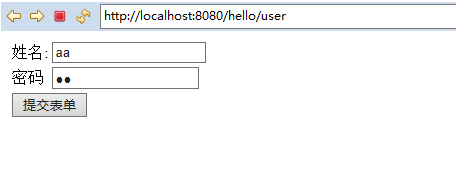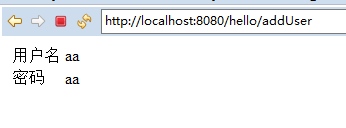以user为例,包含username, password字段.
user.java
public class User {
private String username;
private String password;
public String getUsername() {
return username;
}
public void setUsername(String username) {
this.username = username;
}
public String getPassword() {
return password;
}
public void setPassword(String password) {
this.password = password;
}
}
UserController.java代码
import org.springframework.stereotype.Controller;
import org.springframework.web.bind.annotation.ModelAttribute;
import org.springframework.web.bind.annotation.RequestMapping;
import org.springframework.web.bind.annotation.RequestMethod;
import org.springframework.web.servlet.ModelAndView;
import org.springframework.ui.ModelMap;
@Controller
public class UserController {
@RequestMapping(value = "/user", method = RequestMethod.GET)
public ModelAndView user() {
return new ModelAndView("user_index", "command", new User());
}
@RequestMapping(value = "/addUser", method = RequestMethod.POST)
public String addUser(@ModelAttribute("SpringWeb")User user,
ModelMap model) {
model.addAttribute("username", user.getUsername());
model.addAttribute("password", user.getPassword());
return "user_add";
}
}
这里的第一个服务方法user(),我们已经在ModelAndView对象中传递了一个名称为“command”的空User对象,因为如果在JSP文件中使用<form:form>标签,spring框架需要一个名称为“command”的对象。 所以当调用user()方法时,它返回user.jsp视图。
第二个服务方法addUser()将根据URL => HelloWeb/addUser 上的POST方法请求时调用。根据提交的信息准备模型对象。 最后从服务方法返回“userlist”视图,这将呈现userlist.jsp视图。
user_index.jsp 的代码如下所示
<%@ page language="java" contentType="text/html; charset=utf-8" pageEncoding="utf-8"%> <%@ taglib uri="http://www.springframework.org/tags/form" prefix="form"%> <!DOCTYPE html PUBLIC "-//W3C//DTD HTML 4.01 Transitional//EN" "http://www.w3.org/TR/html4/loose.dtd"> <html> <head> <meta http-equiv="Content-Type" content="text/html; charset=utf-8"> <title>添加user信息</title> </head> <body> <form:form method="post" action="/hello/addUser"> <table> <tr> <td><form:label path="username">姓名:</form:label></td> <td><form:input path="username" /></td> </tr> <tr> <td><form:label path="password">密码</form:label></td> <td><form:password path="password"/></td> </tr> <tr> <td colspan="2"> <input type="submit" value="提交表单"/> </td> </tr> </table> </form:form> </body> </html>
user_add.jsp
<%@ page language="java" contentType="text/html; charset=utf-8" pageEncoding="utf-8"%>
<%@ taglib uri="http://www.springframework.org/tags/form" prefix="form" %>
<%@ taglib uri="http://java.sun.com/jsp/jstl/core" prefix="c" %>
<%@ page isELIgnored="false" %>
<!DOCTYPE html PUBLIC "-//W3C//DTD HTML 4.01 Transitional//EN" "http://www.w3.org/TR/html4/loose.dtd">
<html>
<head>
<meta http-equiv="Content-Type" content="text/html; charset=utf-8">
<title>用户信息显示</title>
</head>
<body>
<table>
<tr>
<td>用户名</td>
<td>${username}</td>
</tr>
<tr>
<td>密码</td>
<td>${password}</td>
</tr>
</table>
</body>
</html>
如图:

